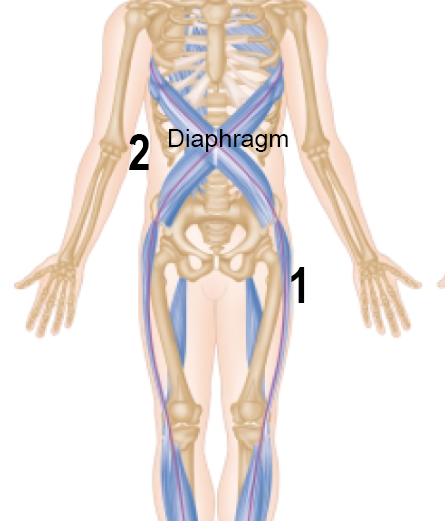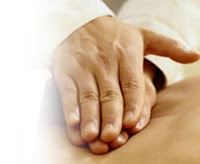Why side stitches occur in runners and other athletes and how to avoid them
Runners and other athletes are familiar with side stitches, that pain that occurs while running in the abdomen by your diaphragm. Often, they appear as a cramp which in some instances gradually worsens. Sometimes, you may be able to work through or breathe through the cramp yet, at other times; it will stop someone in their activity until the pain from the stitch passes. Often, they are accompanied by shoulder and shoulder blade pain as well.
What is the older classic thinking behind side stitches?
One source has described stitches as follows:
“Side stitches are a muscle spasm of the “diaphragm”. The diaphragm is a dome-shaped muscle that separates the chest cavity from the abdominal cavity. In essence, it provides a boundary between the organs of the abdomen and the chest cavity where the heart and lungs are located.
The diaphragm assists in breathing. When we inhale, taking air into the lungs, the diaphragm moves down. When we exhale, the diaphragm moves up. (This detail becomes important later.)
Spasms of the diaphragm occur may because of the movement of the internal organs as they jounce up and down while running, thus pulling down and straining the diaphragm as it moves up while exhaling.
The liver in particular is usually the cause of this. It is attached to the diaphragm by two ligaments. The liver is the largest organ in the abdominal cavity and is situated in the upper right abdomen. Hence most people experience stitches on their right side, immediately below the ribs. A stomach full of food may cause this as well.
In addition, most runners are “footed”. They begin and end a respiratory cycle on the same foot while running, usually in a stride to breathing ratio of 4:1 while jogging and 2:1 while running very fast. As the runner’s breathing then becomes synchronized with his/her stride, exhalation consistently occurs on the same leg. If one repeatedly exhales (causing the diaphragm to move up) when the right foot hits the ground (forcing the organs on the right side of the body to move down), a side stitch may develop.”
This was the thinking by experts published in 2014.
Here is my newer theory on side stitches based on 30 years of helping track and field athletes.
A more likely source that is rarely spoken about is the effect of body mechanics that eventually create the problem in the first place. Our regular readers have heard about the idea of how body asymmetry and foot overpronation affects running gait, with over and under striding and it affects the core as it torques. Side stitches are a side effect of this mechanism. As the myofascia surrounding the core muscles causes distortion of the pelvis, it also torques the rib cage, which affects breathing. It also affects the function of the diaphragm.
 While the latest medical resources are still unsure of the reasons behind why a stitch occurs, years of testing firing patterns on patients demonstrates that there is high reliability between poor firing patterns that cause recruitment into the oblique muscles and the surrounding fascial lines (1) and stitches that occur at the insertion of the diaphragm on the opposite side (2). As seen in this diagram taken from Myers’s Anatomy Trains, the fascia crosses over. If the firing pattern for example on the left side is poor due to tight fascia, the fascia that crosses the abdomen onto the other side will also tighten affecting the function of the diaphragm, your stride, and even your arm and shoulder movement. This can also result in shoulder blade pain on the side of a stitch as well.
While the latest medical resources are still unsure of the reasons behind why a stitch occurs, years of testing firing patterns on patients demonstrates that there is high reliability between poor firing patterns that cause recruitment into the oblique muscles and the surrounding fascial lines (1) and stitches that occur at the insertion of the diaphragm on the opposite side (2). As seen in this diagram taken from Myers’s Anatomy Trains, the fascia crosses over. If the firing pattern for example on the left side is poor due to tight fascia, the fascia that crosses the abdomen onto the other side will also tighten affecting the function of the diaphragm, your stride, and even your arm and shoulder movement. This can also result in shoulder blade pain on the side of a stitch as well.
The long-term result is slower runs, a shorter stride, and the likelihood of running injuries as the fascial lines tighten over time. This may explain why some runners have so many complaints and problems while others have few. Side stitches may be an indicator of future running problems as the body adapts poorly with tight fascia that tightens, increasing the ground forces while you run and leaving you more prone to impact injuries such as shin splints, plantar fasciitis, and even stress fractures.
When testing firing patterns in our office during an evaluation, recruitment is visible and felt by both the doctor and the patient and the area of the pain coincides with the area of the pain. This is most likely the true cause of most side stitches.
Relieving Side Stitches
Often, you can stop breathing and stretch out the spasm so you can continue. Rather than changing your routine, perhaps we need to be proactive rather than reactive which is what to do when the stitch occurs.
Since body mechanics plays a larger role than most researchers offer in their explanations, there are things you can do that are effective in reducing pelvic distortion, recruitment while improving your running form.
- Wear either off the shelf or custom insoles – You need to address the asymmetry. Asymmetry is easily helped with the right insert.
- Use foam rolling to reduce the tightness in the core and legs – this helps improve core function and the firing patterns that occur in muscle groups when you run. (visit our YouTube channel for video’s on this geared toward running.)
- See a sports certified chiropractor who specializes in runners if you are having other running injuries. It is very difficult to be objective about your own body, and sometimes an outside source can be quite helpful. If you resolve the mechanism causing stitches, chances are you will prevent some future injuries while also. resolving current running issues.
- See a specialist in myofascial release. Spasms of the diaphragm may be relieved using the myofascial release to reduce adhesions from the abdominal region muscle insertions and the diaphragm.
- Perform exercises such as bird dogs and supermans to improve running posture.
- Make sure your shoes fit properly. Tight or narrow running shoes will reduce foot and ankle movement which may result in problems in the toes, knees, hips, ankles, and lower back. Check out how to properly fit a shoe video here.
Often, the solution to side stitches requires simple changes to running style and proper management of the problem. We believe in keeping it simple, rather than a specialist for all problems which usually results in higher costs, less efficient and effective care, and frustration. Runners and other athletes do best with a primary care approach that is holistic to the musculoskeletal system. Sports Chiropractors are your best choice to help you solve these problems using a hands-on approach to care. Book your first visit here.
costs, less efficient and effective care, and frustration. Runners and other athletes do best with a primary care approach that is holistic to the musculoskeletal system. Sports Chiropractors are your best choice to help you solve these problems using a hands-on approach to care. Book your first visit here.
